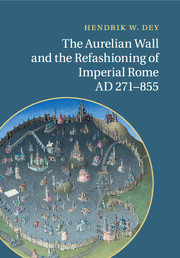Book contents
- Frontmatter
- Contents
- List of abbreviations
- List of figures
- Acknowledgements
- Introduction
- 1 Toward an architectural history of the Aurelian Wall, from its beginnings through the ninth century
- 2 Planning, building, rebuilding, and maintenance: the logistical dynamics of a (nearly) interminable project
- 3 Motives, meaning, and context: the Aurelian Wall and the late Roman state
- 4 The city, the suburbs, and the Wall: the rise of a topographical institution
- 5 Sacred geography, interrupted
- 6 The Wall and the “Republic of St. Peter”
- Conclusion
- Appendices
- Bibliography
- Index
6 - The Wall and the “Republic of St. Peter”
Published online by Cambridge University Press: 19 May 2011
- Frontmatter
- Contents
- List of abbreviations
- List of figures
- Acknowledgements
- Introduction
- 1 Toward an architectural history of the Aurelian Wall, from its beginnings through the ninth century
- 2 Planning, building, rebuilding, and maintenance: the logistical dynamics of a (nearly) interminable project
- 3 Motives, meaning, and context: the Aurelian Wall and the late Roman state
- 4 The city, the suburbs, and the Wall: the rise of a topographical institution
- 5 Sacred geography, interrupted
- 6 The Wall and the “Republic of St. Peter”
- Conclusion
- Appendices
- Bibliography
- Index
Summary
The Aurelian Wall and the post-Roman “state,” from Justinian to Charlemagne
With the final triumph of Justinian's armies over the Goths and the restoration of Italy to “Roman” rule in the early 550s, the administration of Rome passed into the hands of representatives of the imperial government in Constantinople. The transition to Byzantine rule in the reconstituted province received its legal underpinnings with the “Pragmatic Sanction” of 554, which included amongst its provisions a section on the upkeep of the ancient capital, aimed chiefly at the preservation of vital infrastructure. The banks of the Tiber, the forum, the seaports, and the aqueducts were specifically recommended to the care of the supervising authorities, alongside “public buildings” in general, amongst which Rome's battered walls must have figured prominently. Though the titles and responsibilities of the various officials employed in the urban administration did gradually evolve, the governance of the city and the maintenance of its physical building stock remained for the next century and a half – at least in theory – the task of civil servants in the employ of the central government in Constantinople.
The Pragmatic Sanction was addressed to the victorious commander Narses and to Antiochus, Praefectus per Italiam, who together exercised effective authority in the vacuum left by the collapse of the Gothic regime. As a more permanent and articulated bureaucratic apparatus took shape over the following decades, despite the chaos occasioned by the Lombard invasion, the positions occupied by these two individuals were institutionalized in lasting form.
- Type
- Chapter
- Information
- Publisher: Cambridge University PressPrint publication year: 2011



